How to Create and Manage an AWS VPC
This how-to assumes:
- Basic familiarity with System Initiative
- Are familiar with AWS VPC
It will teach you how to create a best practice AWS VPC and manage it with System Initiative.
We will cover:
- The creation of a highly available VPC that spans multiple availability zones.
- A VPC configured with public and private subnets.
- The networking required to allow outbound traffic for resources on the private subnets.
- The networking required for the communication with the internet.
What it will look like when completed
When you have completed this guide, you should have Components that look like this in your Grid:

and like this in your Map:
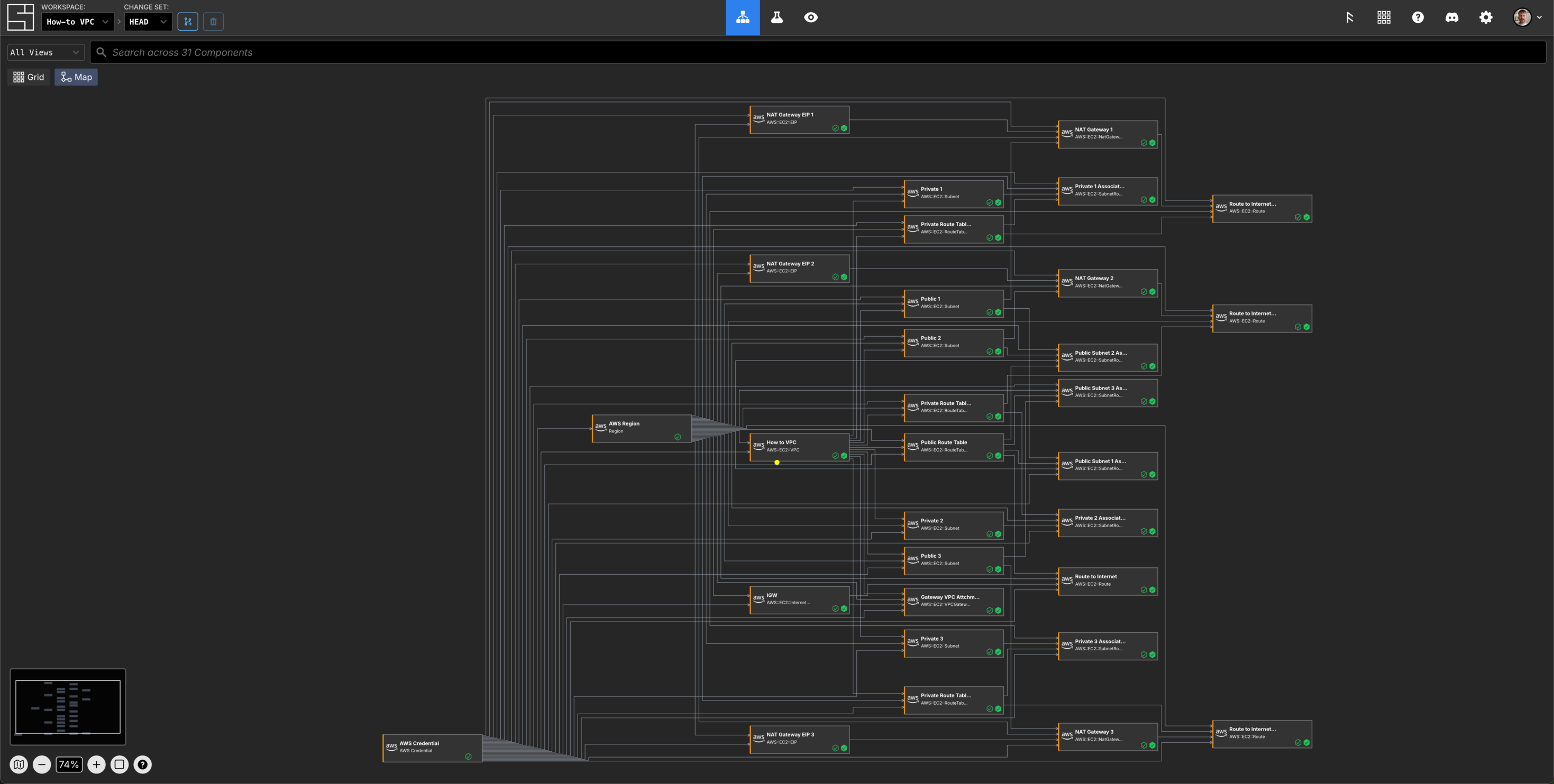
Create a Change Set

Create a Change Set named How-to VPC.
Create AWS Credentials
Press N (or click Add a component) search for AWS Credential, select it then hit Enter to create an AWS Credential Component.
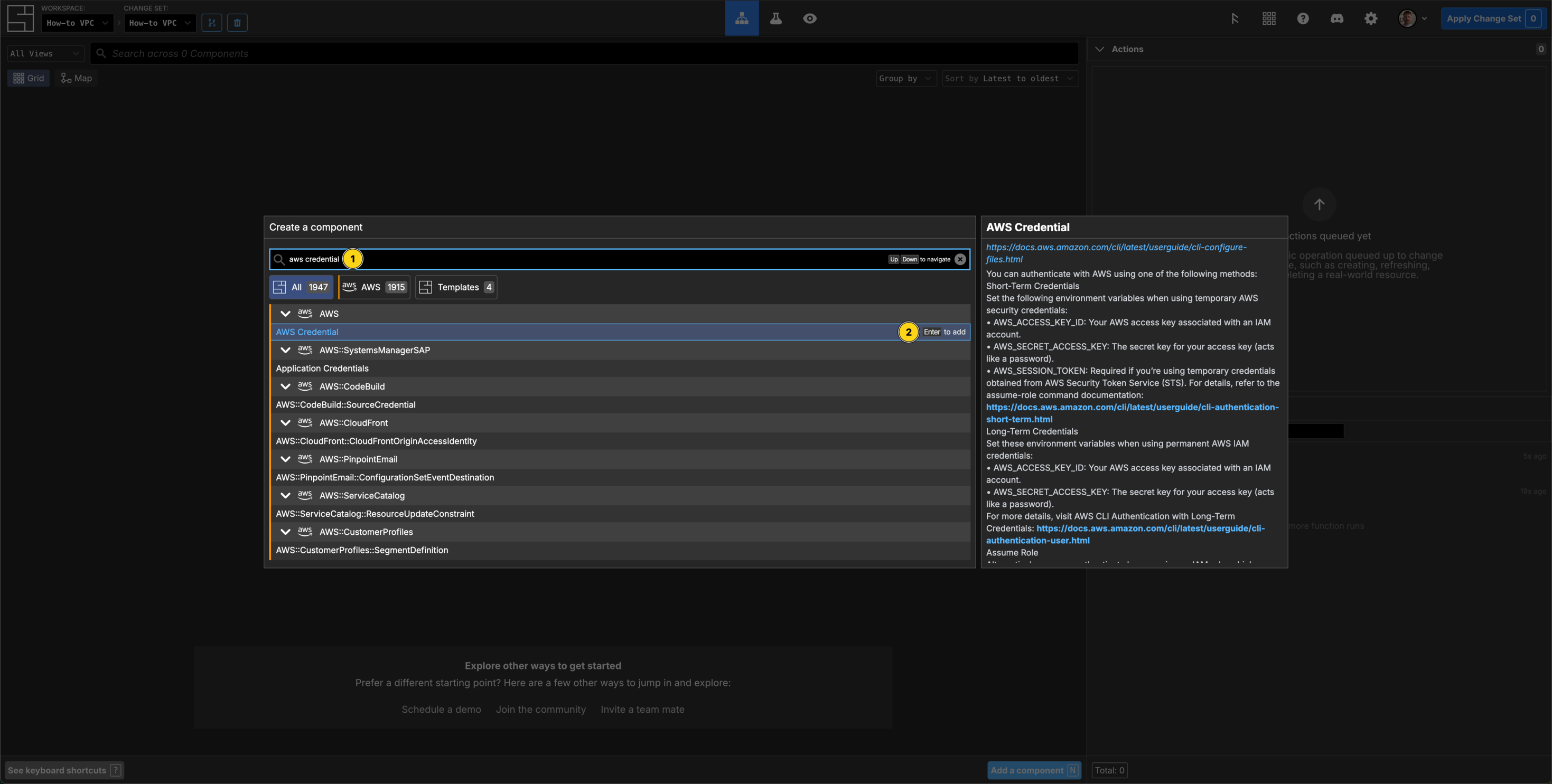
Now configure your AWS Credentials to a valid AWS account, and press Add Secret, hit Esc to return to the Grid. You now have a valid AWS Credential component to use for this VPC.

Select an AWS Region
Press N, then search for, select and add an AWS Region to your Change Set. Name the Component, AWS Region, set the region property tous-east-1 and Subscribe the credential property to your AWS Credential. Hit Esc to return to the Grid.
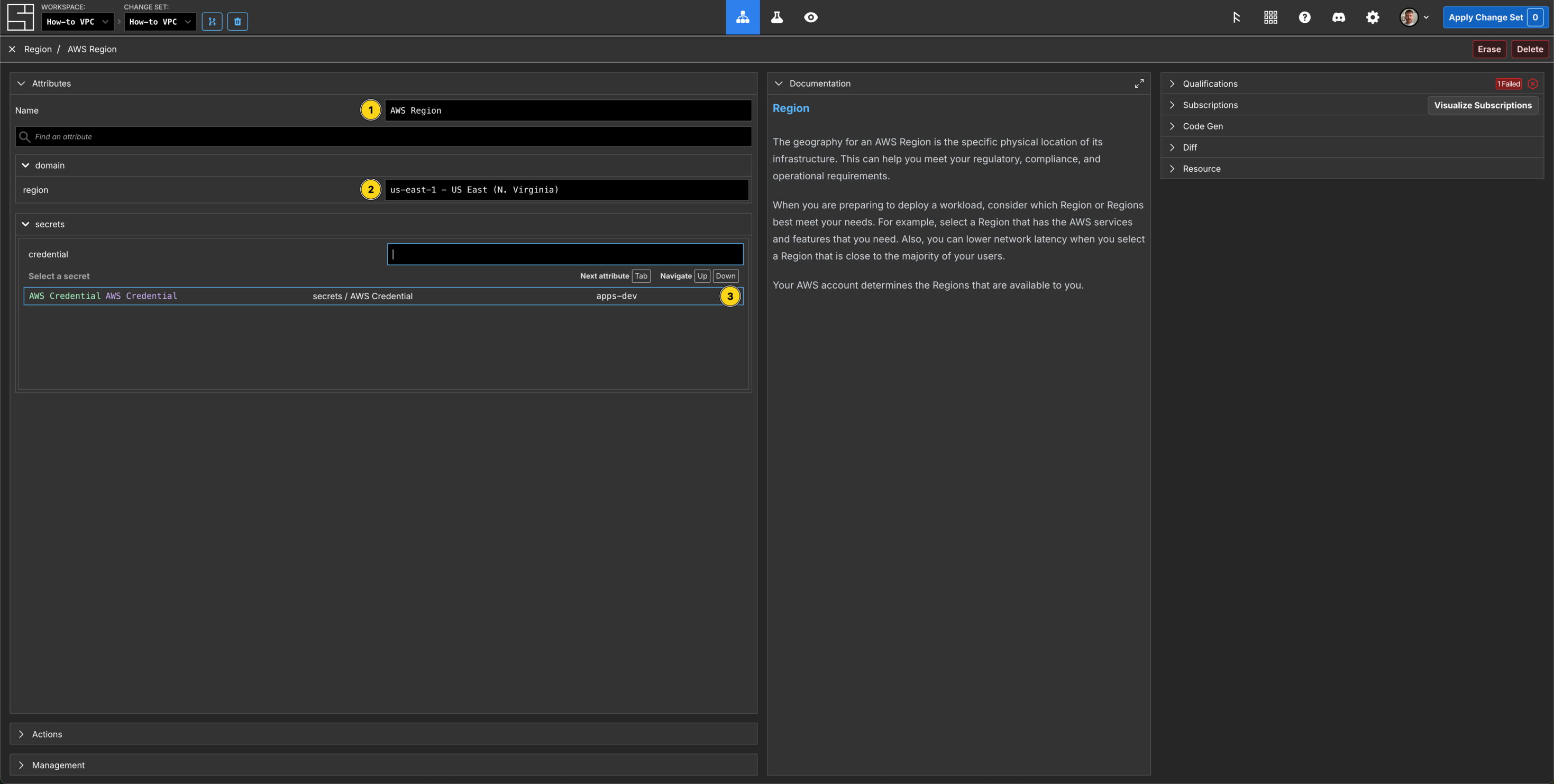
Create a VPC Component
Press N, then search for, select and add an AWS::EC2::VPC Component.
Set the Component name to be How to VPC.
Set the CidrBlock property to 10.0.0.0/16
Set EnableDnsHostnames to true.
Set EnableDnsSupport to true.
Subscribe the region property to your AWS Region.
Subscribe the credential property to your AWS Credential.
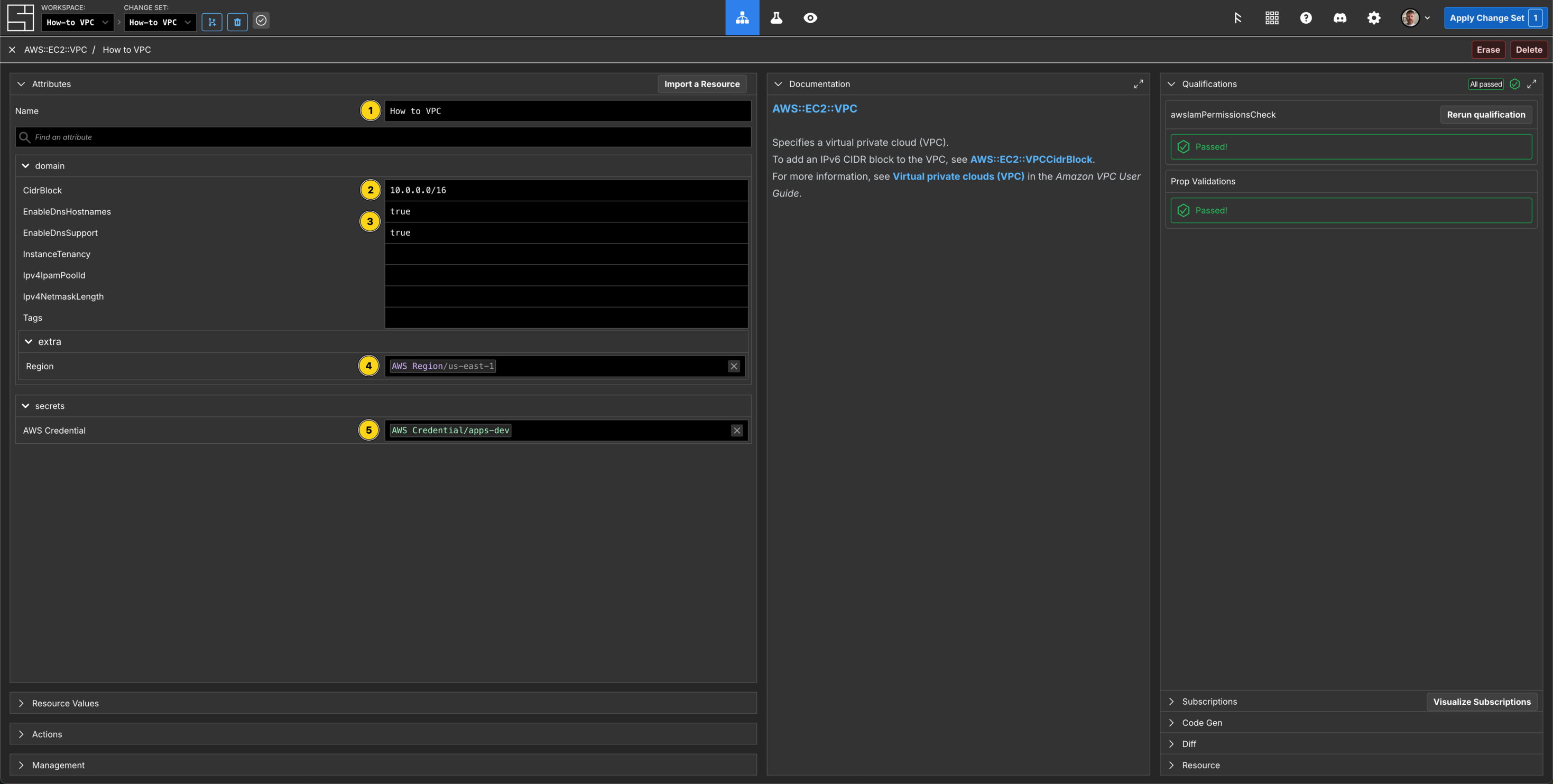
Press Esc to return to the Grid.
Create the Public Subnet Components
This VPC will span multiple availability zones in our AWS Region. Add a AWS::EC2::Subnet Component to your Change Set, then right click it, and press D to duplicate the Component (add a prefix to each duplicate of Public if you like) until you have 3 of them.
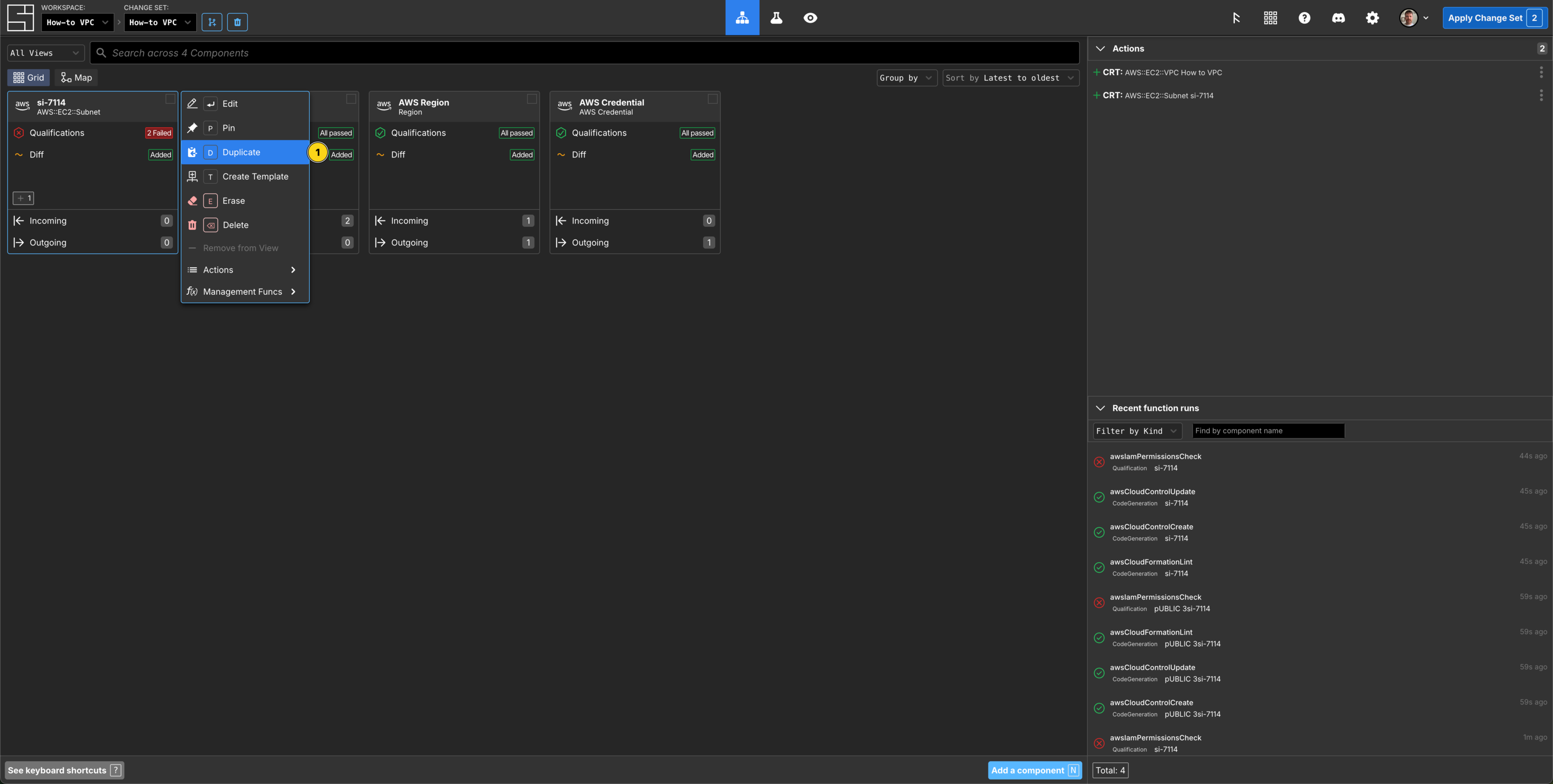
Then Configure them as follows:
| Component Name | CidrBlock | AvailabilityZone | MapPublicIpOnLaunch |
|---|---|---|---|
| Public 1 | 10.0.128.0/20 | us-east-1a | true |
| Public 2 | 10.0.144.0/20 | us-east-1b | true |
| Public 3 | 10.0.160.0/20 | us-east-1c | true |
Subscribe the VpcId property to your AWS::EC2::VPC Component named How to VPC, for each of the Subnets.
Subscribe to your Region and AWS Credential properties for each of the Subnets. When you are done with Subnet 3, press Esc to return to the Grid.
Create the Elastic IP Components
Add an AWS::EC2::EIP Component to the Grid, hit Esc then duplicate (D) until you have 3 of them.
Set the names of the Components to be NAT Gateway EIP (1|2|3) - the index should align with each of the Subnets, and match the corresponding NAT Gateway Components.
Set the Domain of each of the Elastic IP Components to be vpc.
Subscribe to your Region and AWS Credential properties for each of the NAT Gateway EIP Components.
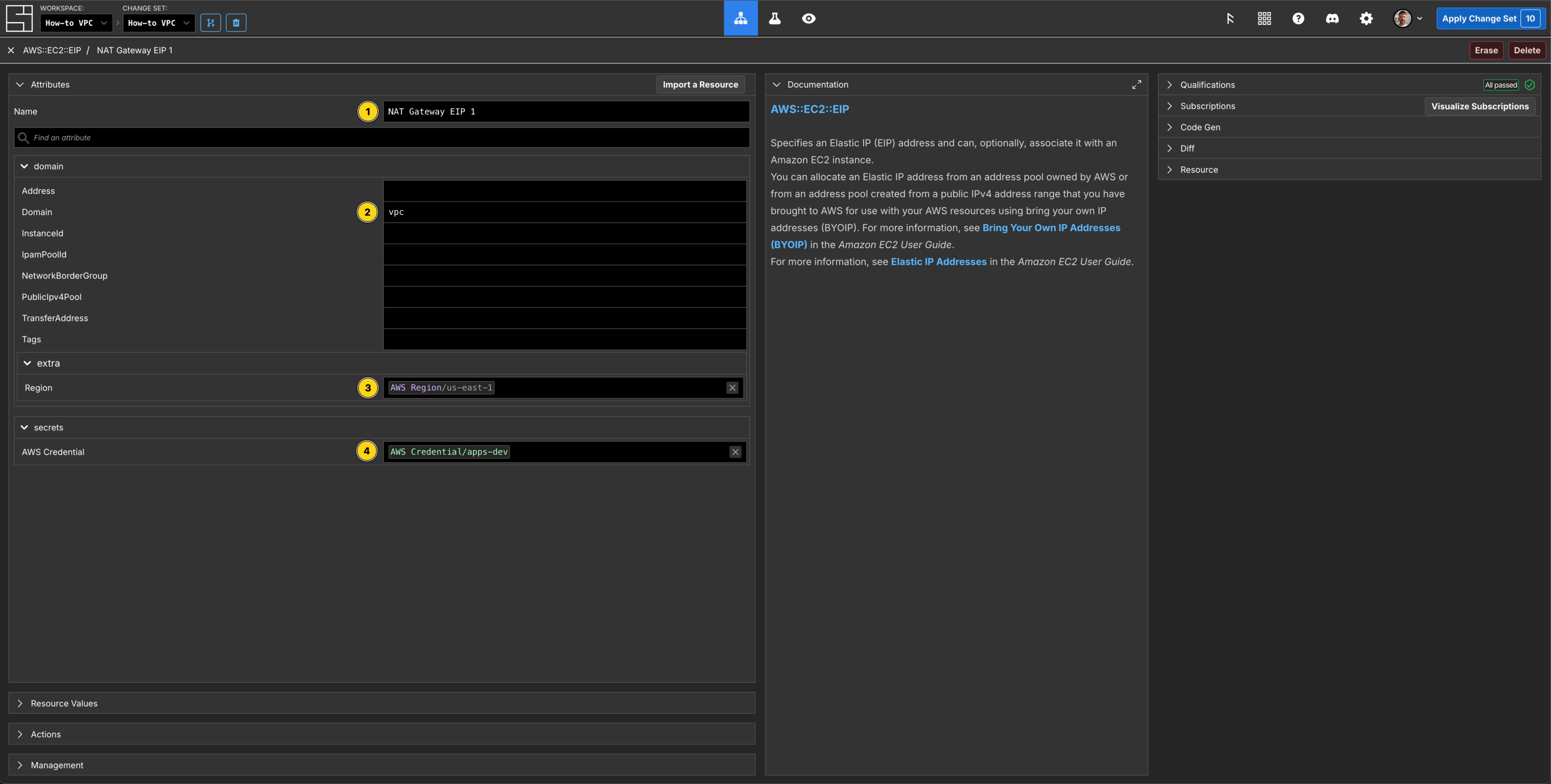
Press Esc to return to the Grid.
Create the NAT Gateway Components
Add an AWS::EC2::NATGateway Component to the Grid, hit Esc then duplicate (D) until you have 3 of them.
Set name names of each of the Components to be NAT Gateway (1|2|3) - the index should align with each subnet.
In NatGateway 1, subscribe the SubnetId property to your AWS::EC2::Subnet Component named Public 1. Repeat this for NatGateway 2 and 3 to subscribe to the matching SubnetId properties.
In NatGateway 1, subscribe the AllocationId property to your AWS::EC2::EIP Component named NAT Gateway EIP 1. Repeat this for NatGateway 2 and 3 to subscribe to the matching AllocationId properties.

Set the ConnectivityType of each of the NAT Gateway Components to be public.
Subscribe to your Region and AWS Credential properties for each of the NAT Gateway Components.
Press Esc to return to the Grid.
Create the Internet Gateway and VPCGatewayAttachment Components
Add an AWS::EC2::InternetGateway Component to the Grid.
Set the name to be IGW.
Subscribe to your Region and AWS Credential properties
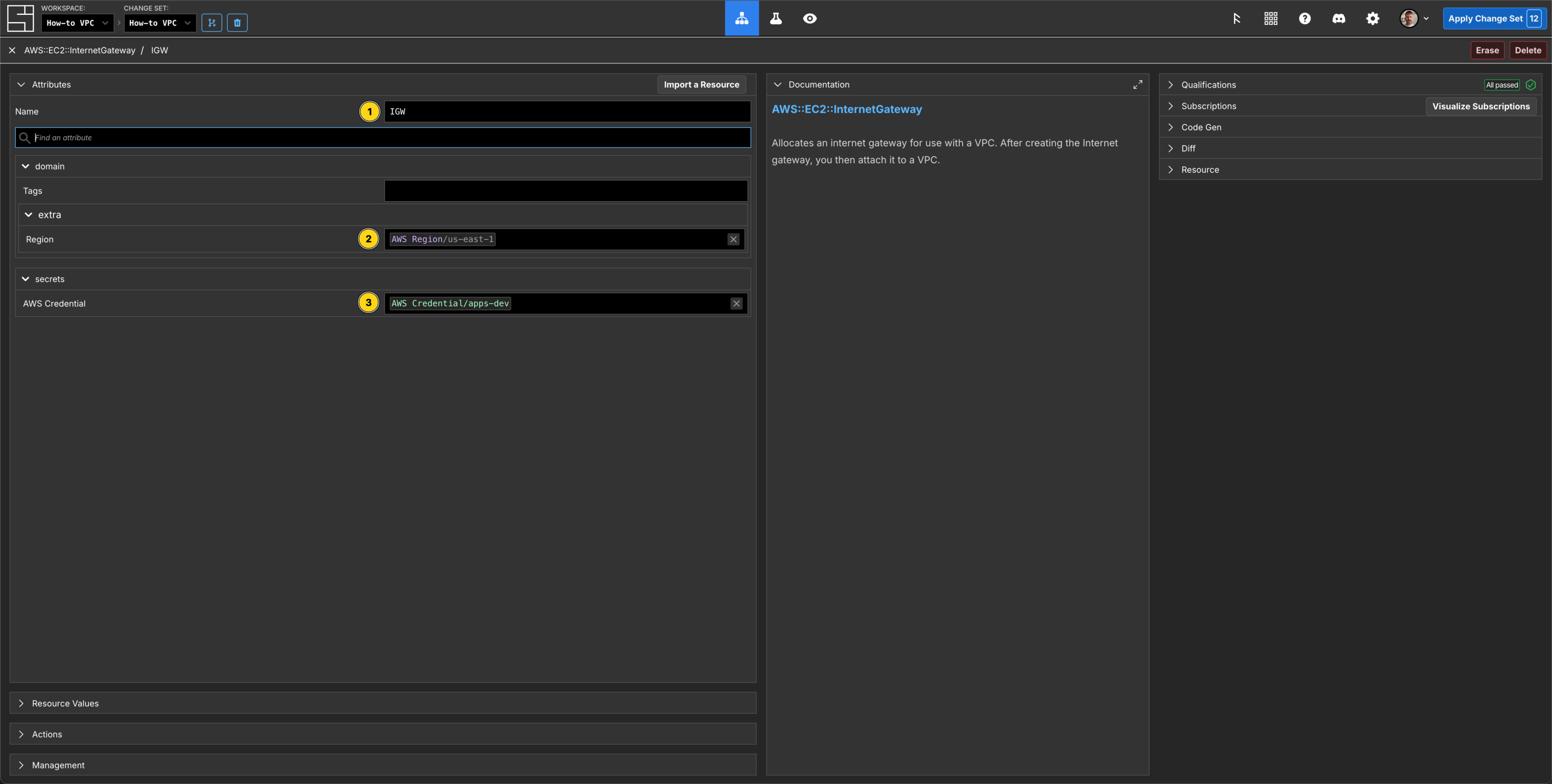
Press Esc to return to the Grid.
Add an AWS::EC2::VPCGatewayAttachment Component to the Grid.
Set the name to be Gateway VPC Attachment.
Subscribe to your VPCs VpcId and your InternetGateways InternetGatewayId.
Subscribe to your Region and AWS Credential properties.

Press Esc to return to the Grid.
Create the Public Route Table and Subnet Route Table Association Components
Add an AWS::EC2::RouteTable Component to the Grid.
Set the Component name to be Public Route Table.
In the VpcId property subscribe to your VPCs VpcId.
Subscribe to your Region and AWS Credential properties.
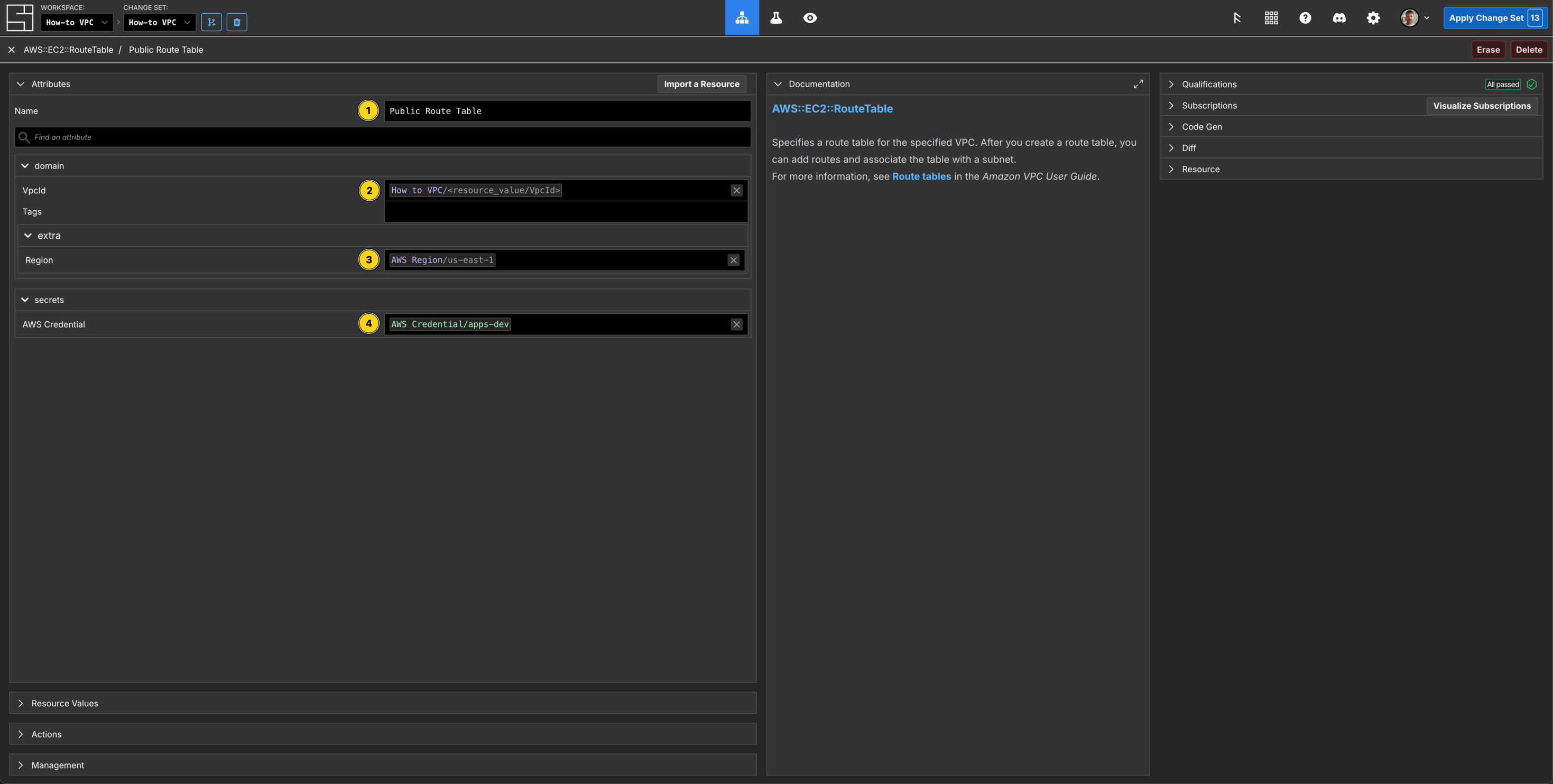
Add 3 AWS::EC2::SubnetRouteTableAssociation components to the Grid, remember you can duplicate using D.
Set the Component names to be Public Subnet (1|2|3) Association.
Subscribe the RouteTableId property to the Public Route Table Component.
Subscribe the SubnetId to the corresponding Subnet (1|2|3) Component.
Subscribe to your Region and AWS Credential properties.
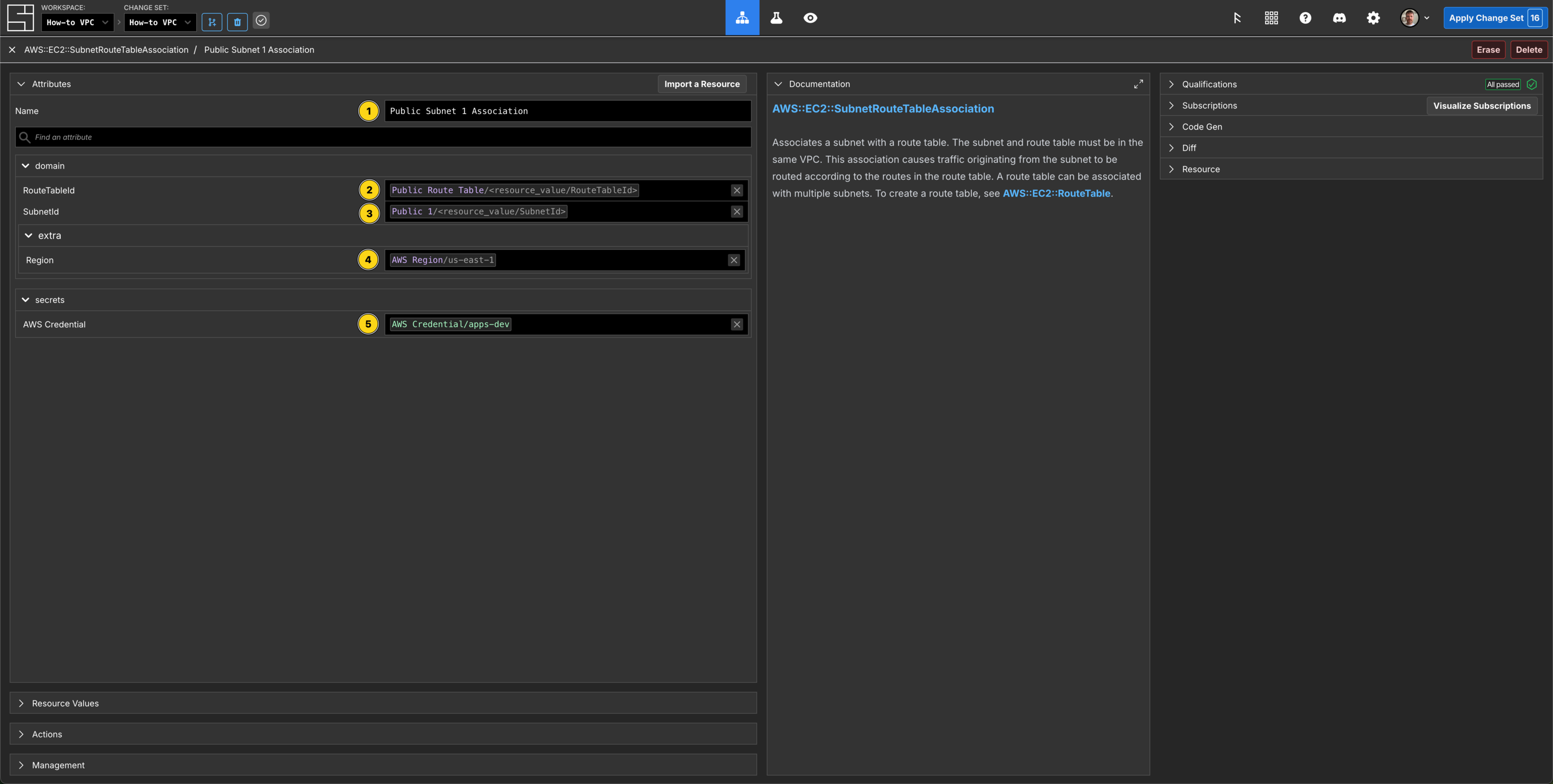
Press Esc to return to the Grid.
Create a Route Component
Add an AWS::EC2::Route Component to the Grid.
Set the Component name to be Route to Internet.
Subscribe the RouteTableId property to the Public Route Table Component.
Set DestinationCidrBlock to be 0.0.0.0/0.
Subscribe the GatewayId property to the Internet Gateway Component.
Subscribe to your Region and AWS Credential properties.
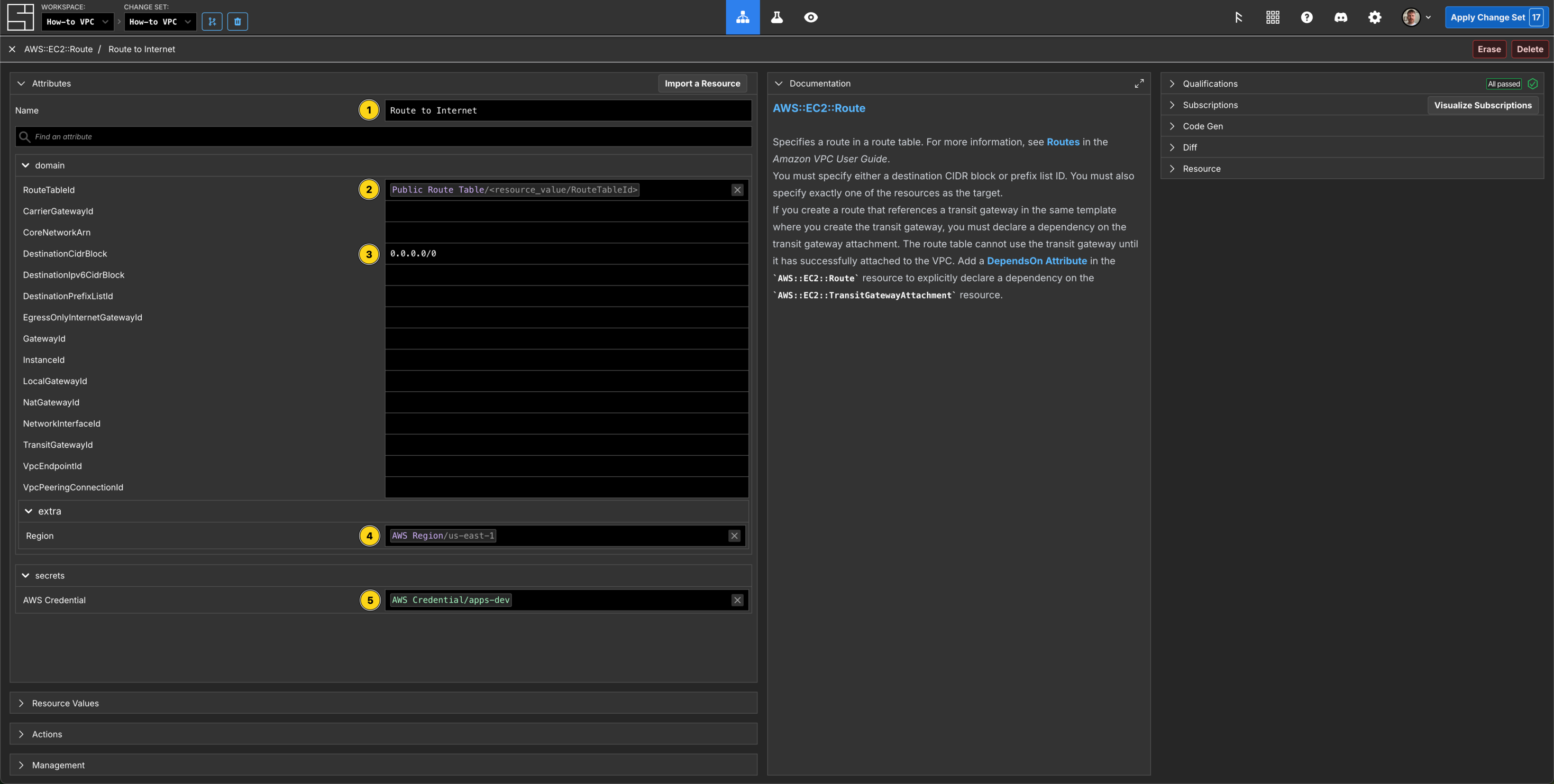
Press Esc to return to the Grid.
Current State of Play
Let's take a look at what we have in our Workspace so far.
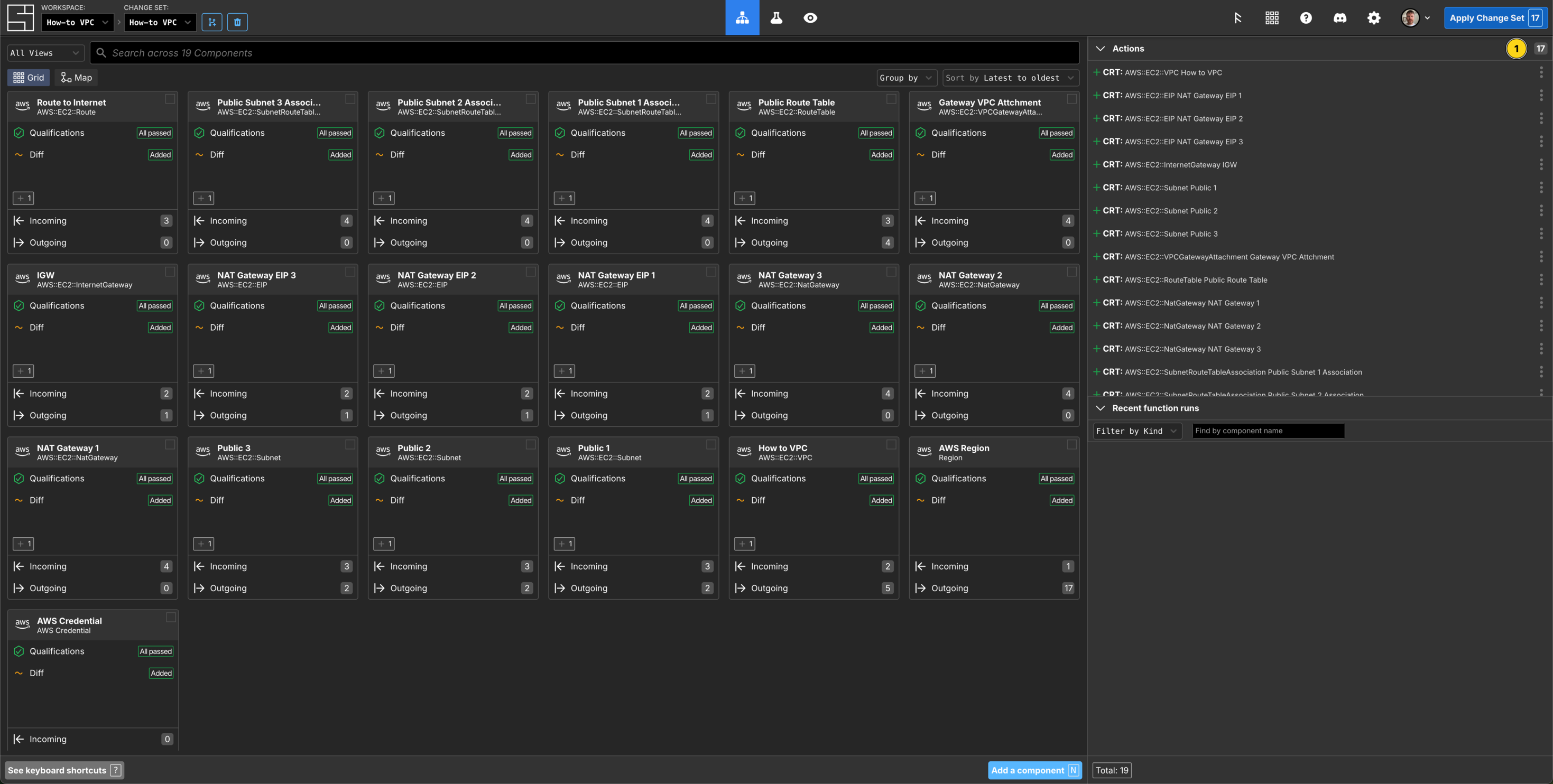
You can see all the components you have created so far in descending order. In the Actions panel on the right hand side you can see there are 17 Actions queued - these are all the real world resources that will be created once you apply your change set.
If you click the Map button in the top left of the Grid, you seen the visual relationship between the components are creating:
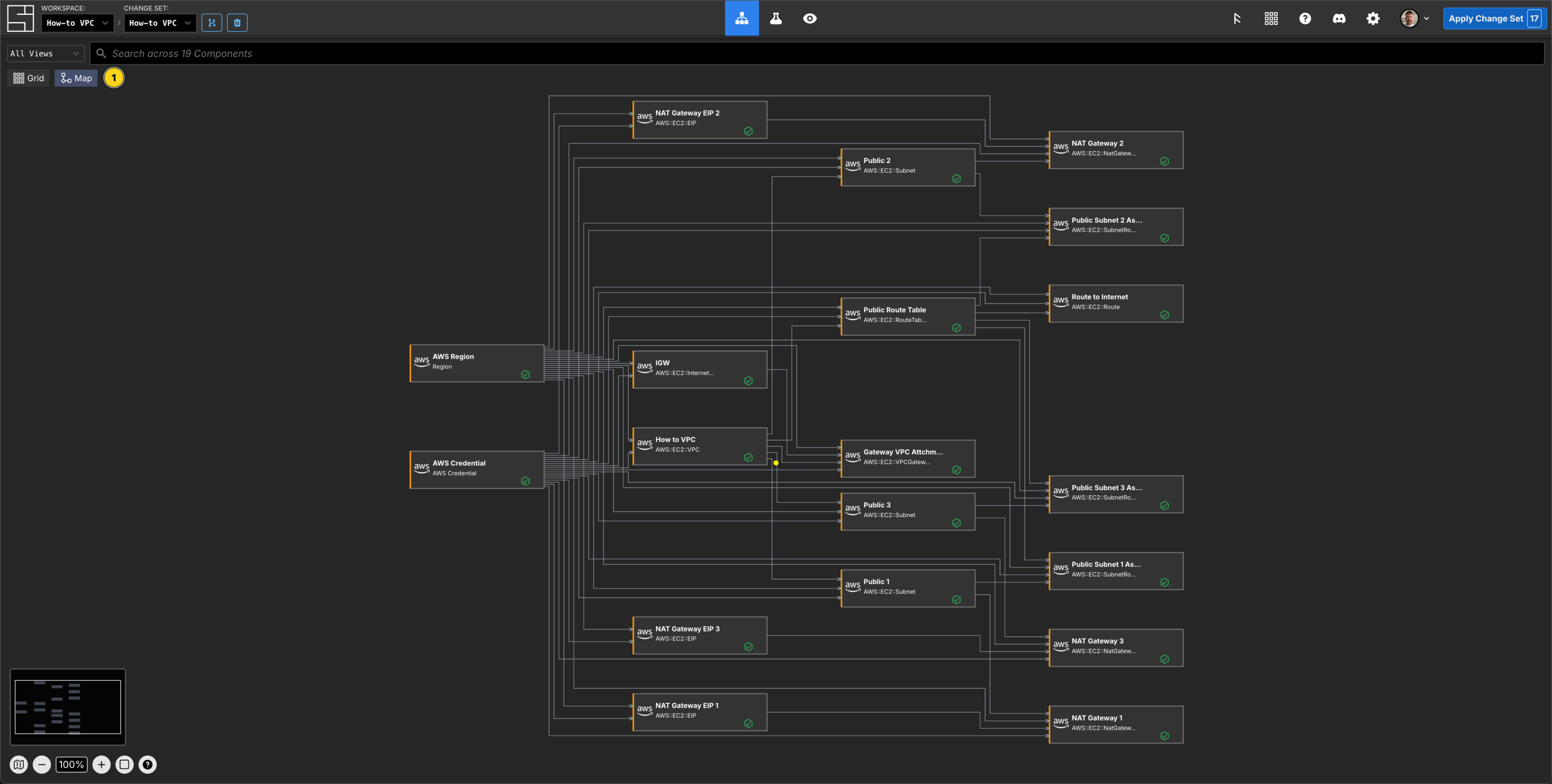
Where the Components are placed on this Map is determined by the dependant property Subscriptions.
Create the Private Subnet Components
On the Map, press the N key, search for Subnet, select AWS::EC2::Subnet and press Enter.
As we need 3 Private Subnets, press Esc to return to the Map from the Component editor, right click the new Subnet Component and Duplicate it twice.
Add 3 AWS::EC2::Subnet Components to your VPC frame and configure them as follows:
| Component name | CidrBlock | AvailabilityZone |
|---|---|---|
| Private 1 | 10.0.0.0/19 | us-east-1a |
| Private 2 | 10.0.32.0/19 | us-east-1b |
| Private 3 | 10.0.64.0/19 | us-east-1c |
Subscribe the VpcId property to the VpcId of the How to VPC Component for each Private Subnet.
Subscribe the Region and AWS Credential properties in each Private Subnet.

Here you can see the 3 Private Subnet components and their property Subscriptions. Click the Grid button in the top left of the screen to return to the Grid.
Create the Private Route Table Components
For each of the Private Subnets, we will need to create an AWS::EC2::RouteTable Component.
Set the names to be Private Route Table 1(2|3) - the index should align with the subnet.
Subscribe the VpcId property to the VpcId of the How to VPC Component for each Private Route table.
Subscribe the Region and AWS Credential properties in each Private Route table.
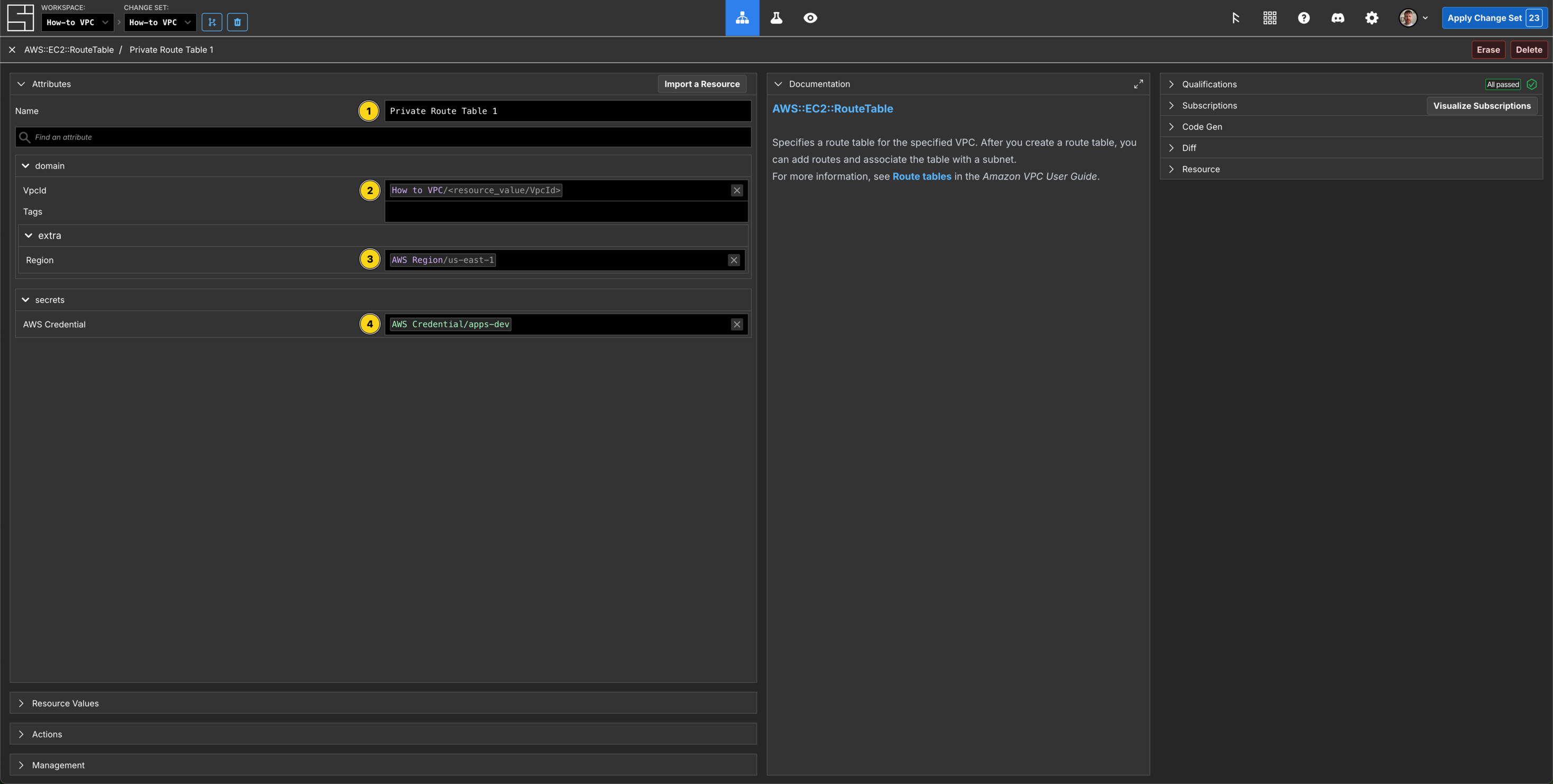
Create the Private Route Components
Add a AWS::EC2::Route Component for each of the Private Route Table Components.
Set the Component name to be Route to Internet (1|2|3) - the index should align with the Private Route Tables you just created.
Subscribe the RouteTableId property to the RouteTableId of the corresponding Private Route Table Component.
Set DestinationCidrBlock to be 0.0.0.0/0.
Subscribe to the corresponding NATGatewayId property of each existing NAT Gateway Component. E.g. Route to Internet 1 subscribes to the NatGatewayId of the NAT Gateway 1 Component.
Subscribe to the Region and AWS Credential properties.
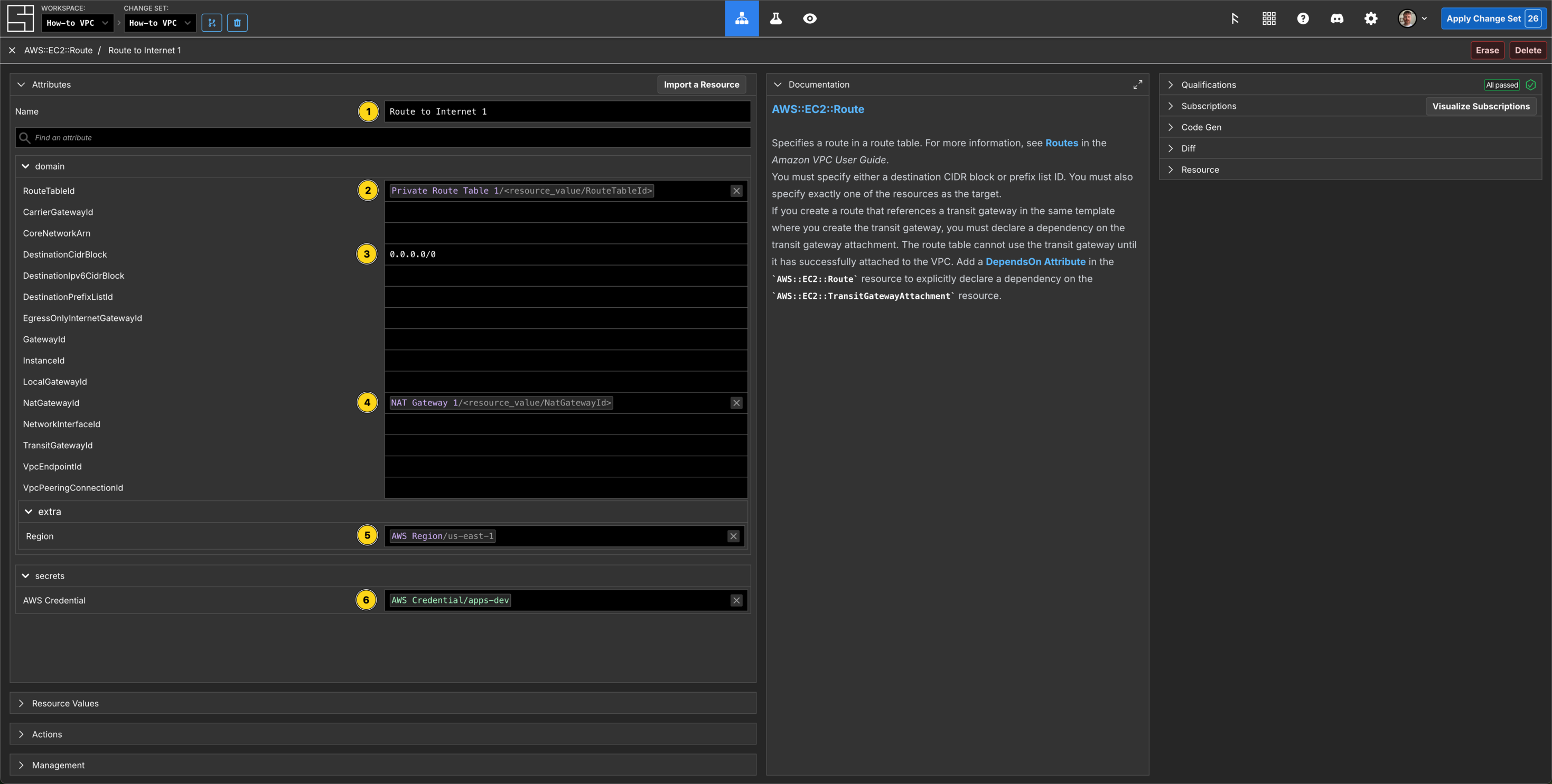
Press Esc to return to the Grid.
Create the Private Subnet Route Table Associations
Add a AWS::EC2::SubnetRouteTableAssociation Component for each of the Private Route Table Components.
Set the name of each of the association components to be Private (1|2|3) Assocation.
Subscribe the RouteTableId property to the RouteTableId of the corresponding Private Route Table Component.
Subscribe the SubnetId property to the SubnetId of the corresponding Private Subnet Component.
Subscribe to the Region and AWS Credential properties.
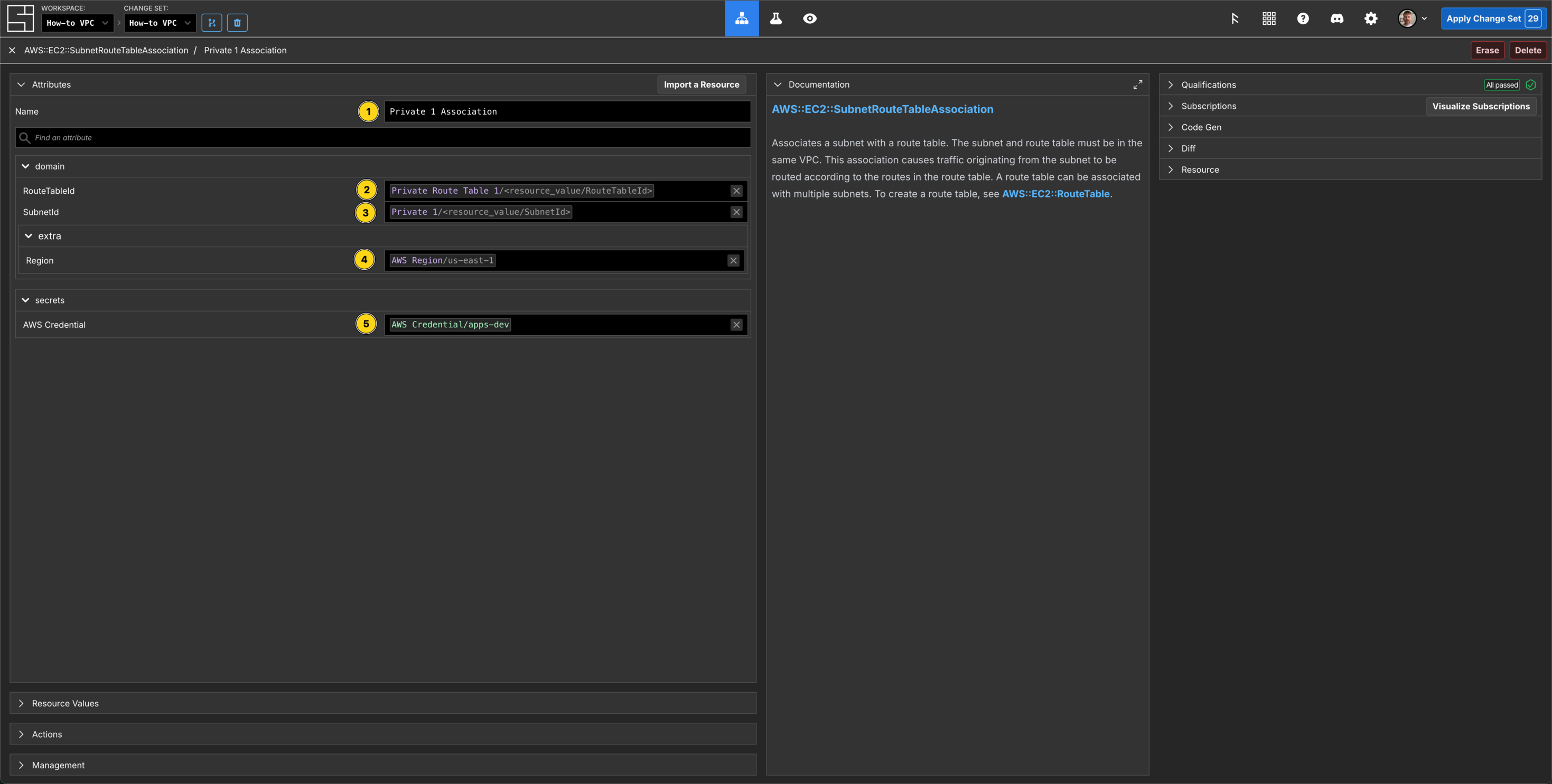
Press Esc to return to your Grid.
Apply your Change Set
Now you can see a scrollable list of 29 pending Create Actions, and all of the individual Components on the Grid required for you to create your How to VPC!
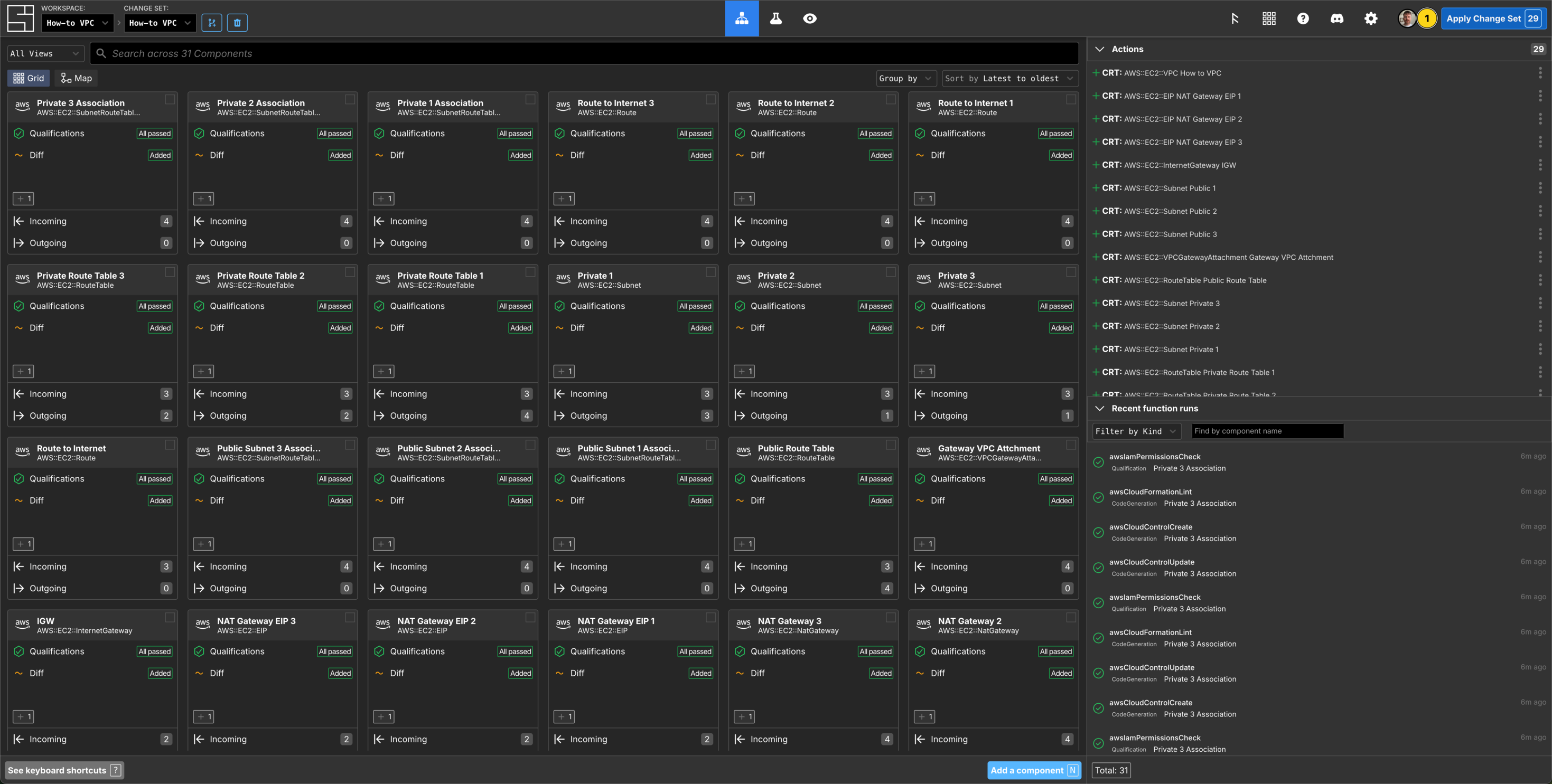
You can also view the Map to see all of your Components:

Now click the Apply Change Set button to:
- Create a VPC Component
- Create 6 Subnets
- Create an Internet Gateway and the VPC Association
- Create 3 Elastic IPs and 3 NAT Gateways
- Create 4 Route Tables and the subnet associations and 4 Routes

Explore your resources
You can review the completed AWS resources by clicking into your Components and viewing the Resource sub-panel for each of your new resources.
Clean Up
Create a new Change Set called Clean up VPC How-to
Cmd/Ctrl + A on the grid to select all Components, then click Delete.
Click Apply Change Set.
All your new resources should be deleted from your AWS account.